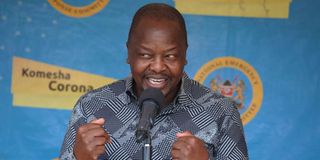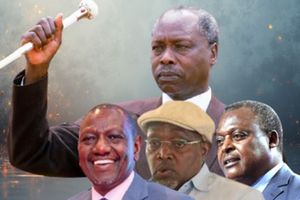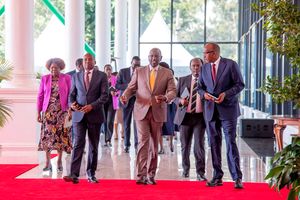Premium
Flattening the curve or masking the numbers?

Health CS Mutahi Kagwe during the Covid-19 daily briefing at Kisii Teaching and Referral Hospital on August 7, 2020.
What you need to know:
- On Monday, the country recorded 144 new cases of the virus from a high of more than 700 cases a few weeks ago.
- The ministry officials have since been gagged from speaking to the media.
In the last three weeks, the country has reported an average of 50 per cent drop in its Covid-19 cases in a sign of slump in new infections, with its laboratory test positivity rate also declining from 12 per cent to 7 per cent.
On Monday, the country recorded 144 new cases of the virus from a high of more than 700 cases a few weeks ago. For many, this indeed has been the sign of the country getting out of the woods in its Covid-19 fight, and flattening the curve.
President Uhuru Kenyatta while speaking during a virtual Covid-19 inter-governmental conference said the country had begun flattening the curve.
“…In the middle of this crisis, the curve is beginning to flatten. However, we must celebrate this happy moment with caution. More so because a curve begins to flatten after it reaches its highest point. This point is also called the inflexion point. And it is the most dangerous point because, the curve can either flatten and de-escalate or take an upward surge,” the President said.
On Sunday, Kenya crossed the 34,000 mark in the number of confirmed cases since March 13, and its latest numbers pointed to decline in new infections, having reported its highest figures in July.
But the World Health Organization (WHO) is calling out this assertion, saying the latest testing results by the Health ministry is masking the true picture of the situation in the country.
Officials gagged
The global health agency statement now corroborates what various Health ministry officials have told the Nation in confidence that “the numbers the country has witnessed in August may not be the true reflection of what is happening in the country”.
The ministry officials have since been gagged from speaking to the media.
On Monday, WHO Kenya office cautioned against interpretation that this decline in reported numbers constitutes a “true decline in the spread of the disease”.
“As further and more widespread laboratory testing and contact tracing takes place, and as further data becomes available on hospital admissions and deaths, the declining number may hopefully be confirmed,” the agency said in a statement.
34,057 confirmed cases
As at Sunday, Kenya had 34,057 confirmed cases, with Nairobi and Mombasa counties having the highest attack rates of 441 and 196 cases per 100,000 populations respectively. “This decline potentially may mask the national picture as other counties are experiencing increasing case numbers,” WHO Kenya said.
“In the first three weeks of August, the general positivity trend for Nairobi has been on a decline. Mombasa has had a positivity rate of less than five per cent...”
In August, Kenya has faced its biggest issue yet to be addressed— inadequate reagent for testing, something Health ministry has conceded to and said would be corrected.
Last week, the Nation reported on how the National Influenza Lab and the Kenyatta National Hospital have a backlog of unprocessed samples due to shortage of the automated kits, like the reagents for Roche. “We are not yet flattening the curve. There are challenges with testing and the reagent issues, which will be sorted out. Kemri will then get back to testing more samples,” Health CAS Mercy Mwangangi said last Wednesday.
This is yet to happen, as number of samples tested keep declining.
WHO is now calling out the government, arguing that Kenya’s testing strategy was not adhered to in the first three weeks of August, and wider targeted low risk groups were tested.




